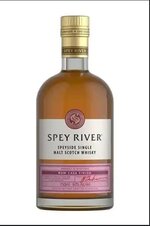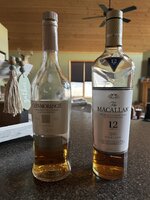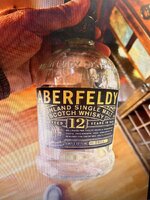Scotch whisky is defined in part by peat, in that they use peat moss in the fire for malting the barley, but Islay is definitely where you see it present more intensely.
Laphroaig 10 is probably the most in-your-face peaty bottling that you'll commonly find. Literally every other bottle they sell is less intensely peated. Lagavulin 16 is a much more refined peaty scotch, by most people's standards. Used to be that Lagavulin was around double the cost of Laphroaig, but Laphroaig has come up to around 1.5x the cost in recent years.
Blended whisky gets a bad wrap. There's certainly some horrible blended whiskies, but frankly, that's not because of the blending. Let's be clear: single malt whiskies are still created by blending, it just means it was blended using all in-house whiskies, and not any sourced from another distillery. It's like saying you can only cook recipes using what you grew on your own farm.
With that being said, while Diageo is a major purveyor of blended whiskies - seeing as they own a good percentage of the Scotch whisky distilleries - there's some other interesting producers.
One in particular stands out for me, and it's one I'd recommend for anyone who hasn't tried their products - Compass Box. They have some standards, but they also have some really fascinating blends. They stand out for me because while they don't limit to a single distillery, they also don't limit to a single recipe (or set of recipes).
I find sharing a dram from someone else's bottle is a great way to find what works for me, and what doesn't. Don't be scared to add a drop of water to the surface, or a few... many distillers/blenders will dilute down to 35-40 proof when tasting, to really dig into the flavors. But know that while a rock of ice might make it seem more quaffable, it's doing so by numbing the flavor. And after the first few, you're enjoying more than you are tasting.
Slange (Slàinte)
Laphroaig 10 is probably the most in-your-face peaty bottling that you'll commonly find. Literally every other bottle they sell is less intensely peated. Lagavulin 16 is a much more refined peaty scotch, by most people's standards. Used to be that Lagavulin was around double the cost of Laphroaig, but Laphroaig has come up to around 1.5x the cost in recent years.
Blended whisky gets a bad wrap. There's certainly some horrible blended whiskies, but frankly, that's not because of the blending. Let's be clear: single malt whiskies are still created by blending, it just means it was blended using all in-house whiskies, and not any sourced from another distillery. It's like saying you can only cook recipes using what you grew on your own farm.
With that being said, while Diageo is a major purveyor of blended whiskies - seeing as they own a good percentage of the Scotch whisky distilleries - there's some other interesting producers.
One in particular stands out for me, and it's one I'd recommend for anyone who hasn't tried their products - Compass Box. They have some standards, but they also have some really fascinating blends. They stand out for me because while they don't limit to a single distillery, they also don't limit to a single recipe (or set of recipes).
I find sharing a dram from someone else's bottle is a great way to find what works for me, and what doesn't. Don't be scared to add a drop of water to the surface, or a few... many distillers/blenders will dilute down to 35-40 proof when tasting, to really dig into the flavors. But know that while a rock of ice might make it seem more quaffable, it's doing so by numbing the flavor. And after the first few, you're enjoying more than you are tasting.
Slange (Slàinte)



